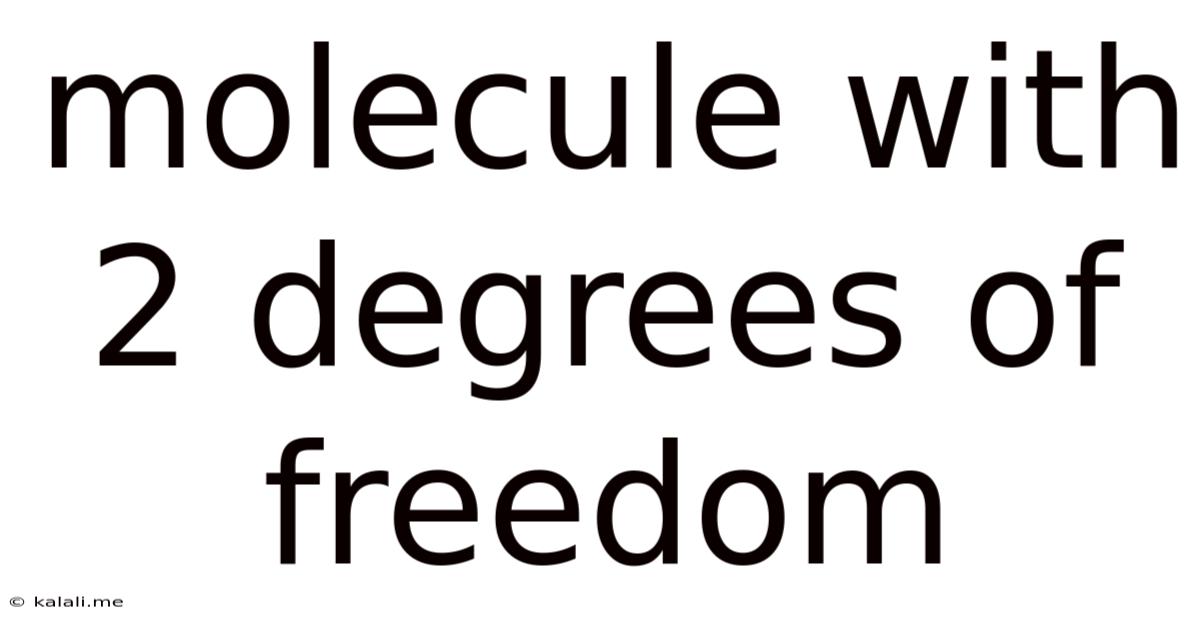Molecule With 2 Degrees Of Freedom
Kalali
Jun 10, 2025 · 3 min read

Table of Contents
Molecules with Two Degrees of Freedom: A Deep Dive into Vibrational and Rotational Motion
Understanding the degrees of freedom of a molecule is crucial in various fields, including thermodynamics, statistical mechanics, and spectroscopy. This article delves into the fascinating world of molecules possessing only two degrees of freedom, exploring the underlying principles and providing examples. This exploration will focus primarily on linear diatomic molecules under specific conditions. These simplified systems offer valuable insights into more complex molecular behaviors.
A molecule's degrees of freedom represent the independent ways it can store energy. These can be translational (movement in space), rotational (spinning about axes), or vibrational (internal atomic motion). A molecule with three atoms, for instance, generally possesses many more degrees of freedom. However, certain conditions and approximations allow us to consider systems with only two.
The Diatomic Linear Molecule: A Simplified Model
Let's consider a diatomic molecule, the simplest example often cited in introductory chemistry. Typically, a diatomic molecule has three translational, two rotational, and one vibrational degree of freedom, totaling six. However, by considering specific constraints or approximations, we can effectively reduce this to two degrees of freedom.
One common scenario leading to this simplification is restricting the molecule's movement to a two-dimensional plane. This eliminates one translational degree of freedom (movement along the z-axis) and one rotational degree of freedom (rotation about the molecular axis). This leaves us with two degrees of freedom: one translational (movement within the plane) and one vibrational (stretching of the bond between the two atoms).
Conditions for Two Degrees of Freedom
Several conditions can lead to a diatomic molecule effectively having only two degrees of freedom. These include:
- Confinement to a 2D plane: Restricting the molecule's movement to a plane significantly reduces the available degrees of freedom. Think of a molecule confined to a very thin film or surface.
- Rigid rotor approximation: While vibration exists, the vibrational energy levels might be very high, rendering the vibration negligible at low temperatures. This approximates the molecule as a rigid rotor, focusing primarily on rotational motion within the 2D plane. This assumption leads to only two degrees of freedom in a two-dimensional plane.
- Specific experimental setups: Certain experimental techniques might isolate specific motions, effectively allowing us to focus only on two degrees of freedom for the sake of analysis and understanding the underlying principles of motion.
Implications and Applications
Understanding systems with reduced degrees of freedom is essential for several reasons:
- Simplified Models: These simplified models make complex systems more approachable, enabling theoretical calculations and simulations that would be computationally intractable with a full six degrees of freedom.
- Approximation Techniques: Understanding these simplified scenarios helps us build and test more complex approximations used in various fields, such as statistical mechanics.
- Foundation for Advanced Concepts: Grasping the behavior of molecules with only two degrees of freedom forms the base understanding for grasping more complex vibrational modes, rotational isomerism, and other nuanced phenomena.
Beyond the Diatomic: Other possibilities
While diatomic molecules provide the clearest examples, other systems can also be approximated to effectively have only two degrees of freedom under very specific circumstances and limitations. This often involves considering highly simplified models. Always remember that this is an approximation and may not represent the true behavior of the molecule completely.
In conclusion, the concept of molecules with only two degrees of freedom is primarily an approximation simplifying a more complex system. While it's rare to encounter a real-world molecule solely exhibiting two degrees of freedom, understanding this simplified model greatly aids in appreciating the concepts of molecular motion and provides a strong foundation for studying more realistic molecular systems.
Latest Posts
Latest Posts
-
How Do You Beat Level 7 On Bloxorz
Jul 01, 2025
-
What Grade Level Do You Learn Algebra 1
Jul 01, 2025
-
How Long Ago Was The 16th Century
Jul 01, 2025
-
How Many Inches Are In 4 Yards
Jul 01, 2025
-
How Many Calories In A Pound Of Hamburger
Jul 01, 2025
Related Post
Thank you for visiting our website which covers about Molecule With 2 Degrees Of Freedom . We hope the information provided has been useful to you. Feel free to contact us if you have any questions or need further assistance. See you next time and don't miss to bookmark.